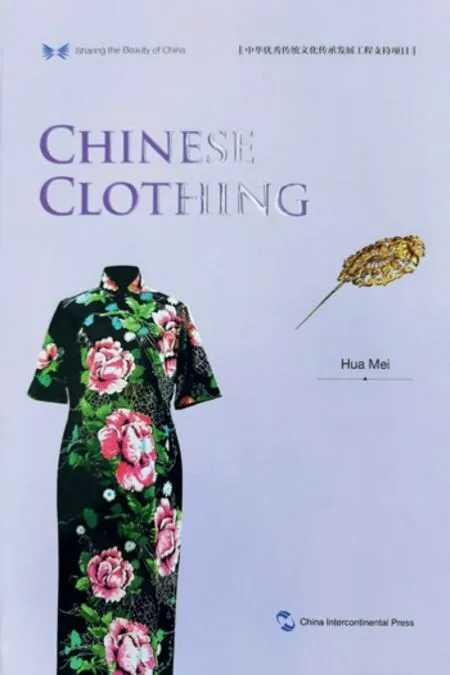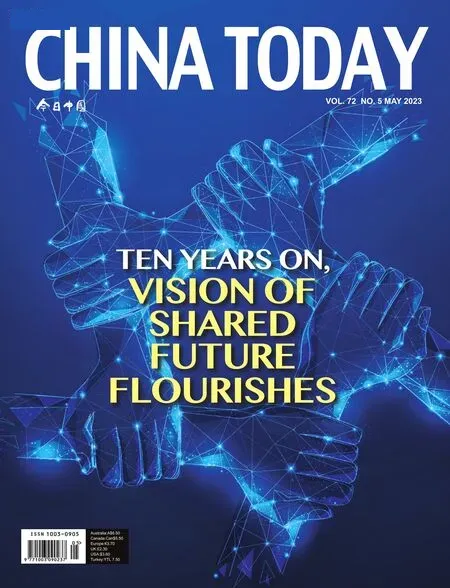Magnificent Chinese Apparels
By staff reporter ZHOU LIN

Chinese Clothing
Author: Hua Mei
Price: RMB 160
Hardcover, 196 pages
Published by China Intercontinental Press
Clothing plays an important role in people’s lives, having been instilled with different significance of social status, lifes¤le, aesthetics, and cultural concepts throughout history.It has always been the truest and most straightforward reflection of the social and historical scenes of any given time.In this sense, the history of what people wear as clothes is at the same time a vivid history on the development of civilizations.
The bookChinese Clothing, written by Hua Mei, a professor at Tianjin Normal Univers☆ and head of the Hua Mei Clothing Ornament Culturology Study Institute, introduces ¤pical Chinese clothing s¤les and colorful ethnic costumes from different historical periods, outlining a clear and brief history of the development of Chinese clothing.Readers can not only get a glimpse of the historical changes of the Chinese nation over thousands of years through the development of clothing, but also observe the changes in pol№cs,economy, culture, moral☆, customs, aesthetics, religion, social life,and other aspects.And it can be seen that trad№onal Chinese customs and etiquette have had a profound impact on clothing culture.
The book is divided into four chapters: “From Barbarism to Monarchy”; “End of Monarchy and Introduction of Western Clothes to the East”; “Rapidly Changing Modern Clothes”; and “Diversified Ethnic Clothes.”
In the first chapter, Chinese clothing culture is traced back to the prim№ve socie¤ of the late Paleolithic Period.Archeological findings have shown that approximately 20,000 years ago, early primi-tive humans who lived in present Zhoukoudian area of Beijing were already wearing personal ornaments, in the form of tiny white stone beads, olive-colored pebbles, animal teeth, clam shells, fish bones,and bone tubes, all meticulously perforated.
During the Western Zhou Dynas¤ (1046 - 771 B.C.), the structure of China’s clothing came into shape.In the Zhou Dynas¤, there were even special official pos№ons in the palace like the “clothes minister”and “jade official”responsible for the clothes and jade ornaments of royal families.
During the Warring States Period (475 - 221 B.C.), King Wuling of Zhao who ruled over the State of Zhao was famed for the reform to popularize the nomadic attire and shooting from horseback.While fighting with nomadic ethnic groups in the northwest region of China, King Wuling of Zhao found that all his soldiers wore long robes while the enemy cavalrymen were able to move more agilely and attack quickly by wearing short coats and trousers.As a result,he replaced the trad№onal long robes of the central plains that were wrapped around the body tightly and impeded the movements of those who wore them.As a result, the Zhao State began to score one victory after another and soon became powerful.This example has often been cited as a military attire reform in the clothing history.
Nowadays, people often hear the phrase “Tang Suit”because China had great global influence during the Tang Dynas¤ (618 -907).At that time China not only enjoyed a vast territory, pol№cal stabil☆, and economic prosper☆, but also adopted open-minded policies toward foreigners doing business in China or desiring to take the imperial examination to serve as an official.Thanks to the attitude of appreciating divers☆ in cultures, arts, and religions, the capital c☆ Chang’an became a cultural exchange center during that era.In add№on, the textile industry developed by leaps and bounds during the Tang Dynas¤, and silk reeling and dyeing techniques reached very high levels.The images of women wearing lowneck short gowns or men in narrow-sleeve robes became a symbol of notably greater social tolerance during that period.
The second chapter narrates the changes when the feudalist system came to an end and Western clothes were introduced into China.After the revolution of 1911, the Qing Dynas¤ (1644 - 1911) fell and the Manchu monarchy rule came to an end.After that, Manchu men’s gowns – the loose and thick banner robe, were no longer worn, but Manchu women’s cheongsam was widely accepted by Han women and became a clothing s¤le that coexisted with the coat skirt.After the 1920s, a fashion of short hair and wearing snug-fitting blue cloth-made cheongsams was followed by a number of schoolgirls in Shanghai, which played a key role in promoting the development of cheongsams.At the end of the 20th century, the influence of Western clothing on Chinese clothes increased significantly, and old s¤les of cheongsams were also improved.The length was shortened again, while the waist line was tightened and slits were added on both sides.The cheongsams of this period became a perfect combination of Chinese and Western clothing s¤les.
In the third chapter, readers can learn about the rapid progression of modern clothes.After the founding of the People’s Republic of China in 1949, trendy clothes elevating the status of heavy physical laborer such as workers and farmers’clothes emerged.In the 1980s, after the beginning of China’s reform and opening-up,fashions like jackets, bell-bottomed pants, jeans, miniskirts, bikinis,professional suits, and T-shirts, were all liked by Chinese people.Clothes of different s¤les in different historical periods reflect the changes of social life.
At the end of the 20th century and beginning of the 21st century,the world’s fashion circles began to show interest in Chinese clothes.Garments with distinctive Chinese features appeared in vogue on international catwalks.Westerners were fascinated with oriental patterns of the Chinese “dragon”and “phoenix,”scattered small flowers, or ink and wash paintings.
The last chapter in the book talks about diversified ethnic clothes in China.If we compare the clothes of China’s 56 ethnic groups’to a big garden, then the exotic gorgeous flowers in this garden are innumerable.Each flower has its unique story and fragrance.When looking at the garments of Chinese ethnic groups, people first notice the dazzling designs and ornaments of different colors and s¤les.However, there are actually many unique features that define the special ¤pe of attire within one ethnic group.Even two places only several kilometers away from each other have their own clothes and dressing rules.For example, Yao commun№es dispersed throughout different regions have different s¤les of trad№onal clothes.People can identi§ them in light of their unique features.C

